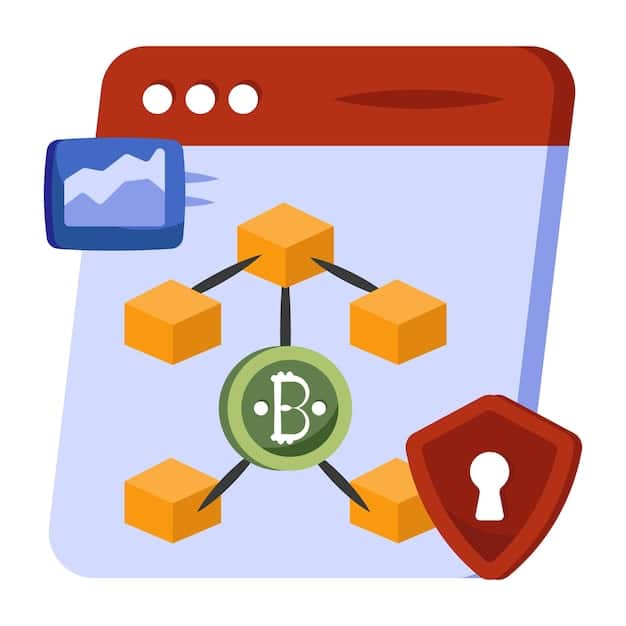Earn Passive Income with Web3: Staking, Lending, & Yield Farming in the US

Earning passive income with Web3 in the US involves leveraging decentralized technologies like staking, lending, and yield farming to generate rewards on cryptocurrency holdings, offering potentially high returns but also carrying significant risks that require careful consideration.
Ready to explore the exciting world of Web3 and discover how you can generate passive income in the US? This guide dives into how to earn passive income with Web3: staking, lending, and yield farming in the US, providing you with the knowledge to navigate this innovative landscape.
Understanding Web3 and Passive Income Opportunities
Web3 represents the next evolution of the internet, characterized by decentralization, blockchain technology, and user empowerment. Within this new paradigm, numerous opportunities have emerged for individuals to earn passive income by leveraging their cryptocurrency holdings.
The concept of passive income involves earning revenue with minimal active effort. In the Web3 context, this often translates to participating in activities that support the network’s operations while being rewarded with additional tokens or cryptocurrency.

What is Web3?
Web3, short for Web 3.0, is the third generation of the internet. It’s characterized by:
- Decentralization: Moving away from centralized servers owned by large corporations.
- Blockchain technology: Utilizing blockchain for secure and transparent transactions.
- Smart contracts: Automating agreements and transactions without intermediaries.
- User ownership: Returning control of data and assets to individual users.
Common Passive Income Strategies in Web3
Several strategies enable users to earn passive income in Web3. These include:
- Staking: Locking up cryptocurrency to support a blockchain network and earn rewards.
- Lending: Providing cryptocurrency to decentralized lending platforms and earning interest.
- Yield farming: Providing liquidity to decentralized exchanges and earning rewards in the form of transaction fees and tokens.
These strategies represent some of the most popular methods for generating passive income within the Web3 ecosystem. However, it’s crucial to understand each method’s intricacies and associated risks before participating.
Staking: Earning Rewards by Securing the Network
Staking is a popular way to earn passive income in Web3, especially within Proof-of-Stake (PoS) blockchains. In essence, staking involves locking up your cryptocurrency holdings to help validate transactions and secure the network. In return, you receive rewards in the form of additional tokens.
The core principle behind staking is to align the interests of token holders with the health and security of the blockchain network. By staking their tokens, users are incentivized to act in the best interest of the network, as any malicious activity could lead to a loss of their staked assets.
Understanding Proof-of-Stake (PoS)
Proof-of-Stake (PoS) is a consensus mechanism where validators are chosen based on the number of tokens they hold and are willing to “stake.” This is different from Proof-of-Work (PoW), where miners compete to solve complex mathematical problems.
How Staking Works
The process of staking generally involves the following steps:
- Selecting a PoS blockchain: Choose a blockchain that uses the PoS consensus mechanism and offers staking rewards.
- Acquiring tokens: Purchase the native tokens of the chosen blockchain.
- Staking your tokens: Delegate your tokens to a validator node or run your own validator node (which requires more technical expertise).
- Earning rewards: Receive rewards in the form of additional tokens, typically distributed at regular intervals.

Risks Associated with Staking
While staking can be a lucrative way to earn passive income, it’s crucial to be aware of the potential risks:
- Slashing: If a validator node acts maliciously or fails to properly validate transactions, a portion of the staked tokens may be slashed (confiscated).
- Unbonding period: Many blockchains have an unbonding period, during which you cannot access your staked tokens. This can be problematic if you need to access your funds quickly.
- Volatility: The value of the staked tokens can fluctuate significantly, potentially offsetting any rewards earned.
Staking provides a way to earn income while contributing to the security of a blockchain. By carefully evaluating the risks and rewards involved, it is important to determine if staking is right for one’s personal financial portfolio.
Lending: Earning Interest with Decentralized Finance (DeFi)
Decentralized Finance (DeFi) platforms have revolutionized lending by creating open, permissionless, and transparent markets for borrowers and lenders. By lending out your cryptocurrency on these platforms, you can earn interest, often at rates higher than those offered by traditional financial institutions.
The key difference between traditional lending and DeFi lending lies in the absence of intermediaries. DeFi platforms use smart contracts to automate the lending process, connecting borrowers and lenders directly. This disintermediation can lead to greater efficiency and higher returns for lenders.
How DeFi Lending Platforms Work
DeFi lending platforms typically operate using the following principles:
- Pool-based lending: Lenders deposit their cryptocurrency into a lending pool, which borrowers can then access.
- Over-collateralization: Borrowers are required to provide collateral, typically in the form of other cryptocurrencies, that exceeds the value of the loan. This helps mitigate the risk of default.
- Automated interest rates: Interest rates are typically determined by the supply and demand for each cryptocurrency within the lending pool.
Popular DeFi Lending Platforms in the US
Several DeFi lending platforms are accessible to US residents. Some popular options include:
- Aave: A well-established platform offering a wide range of cryptocurrencies for lending and borrowing.
- Compound: Another popular platform known for its transparent and algorithmic interest rate model.
- MakerDAO: A platform focused on the DAI stablecoin, allowing users to earn interest by depositing DAI into the DAI Savings Rate (DSR).
Risks Associated with DeFi Lending
While DeFi lending can offer attractive returns, it also carries significant risks:
- Smart contract risks: DeFi platforms rely on smart contracts, which are vulnerable to bugs or exploits. A successful attack could lead to a loss of funds.
- Volatility: The value of cryptocurrencies can fluctuate significantly, potentially leading to liquidation of collateralized loans.
- Regulatory uncertainty: The regulatory landscape for DeFi is still evolving, and new regulations could impact the viability of these platforms.
Carefully researching and understanding the risks associated with any DeFi platform before participating is essential. It’s also important to diversify your lending across multiple platforms to mitigate risk.
Yield Farming: Maximizing Returns with Liquidity Provision
Yield farming is a more complex strategy for earning passive income in Web3 that involves providing liquidity to decentralized exchanges (DEXs). By depositing your cryptocurrency into liquidity pools, you enable trading on the DEX and earn rewards in the form of transaction fees and governance tokens.
The concept of yield farming arose from the need to incentivize liquidity provision on DEXs. Without sufficient liquidity, trades can become expensive and inefficient. Yield farming programs reward liquidity providers with additional tokens, thereby encouraging them to contribute to the DEX.
Understanding Liquidity Pools
Liquidity pools are smart contracts that hold reserves of two or more cryptocurrencies. These pools enable traders to swap between the different cryptocurrencies directly on the DEX, without relying on traditional order books.
How Yield Farming Works
The process of yield farming typically involves the following steps:
- Selecting a DEX and liquidity pool: Choose a DEX that offers yield farming programs and a liquidity pool that aligns with your investment goals.
- Providing liquidity: Deposit an equal value of the two cryptocurrencies required by the liquidity pool.
- Earning rewards: Receive rewards in the form of transaction fees and governance tokens, which can be staked or sold for additional profit.
Risks Associated with Yield Farming
Yield farming is one of the riskiest strategies for earning passive income in Web3, due to the potential for impermanent loss:
- Impermanent loss: This occurs when the price of the two cryptocurrencies in the liquidity pool diverges significantly, resulting in a decrease in the value of your deposited assets compared to simply holding them.
- Smart contract risks: Like DeFi lending platforms, yield farming protocols are vulnerable to smart contract bugs or exploits.
- Rug pulls: In some cases, unscrupulous teams may launch yield farming programs with the intention of siphoning off funds and disappearing.
Given the high risks involved, yield farming is generally only suitable for experienced cryptocurrency users who have a deep understanding of the underlying technology and economics.
Navigating Regulatory Considerations in the US
The regulatory landscape for Web3 activities, including staking, lending, and yield farming, is still evolving in the United States. It’s crucial to stay informed about the latest developments and ensure that you are complying with all applicable laws and regulations.
Various government agencies, including the Securities and Exchange Commission (SEC) and the Internal Revenue Service (IRS), are actively scrutinizing Web3 activities. The SEC is focused on determining whether certain cryptocurrencies or Web3 products should be classified as securities, while the IRS is focused on developing guidance for the taxation of cryptocurrency holdings and transactions.
Potential Regulatory Challenges
Some potential regulatory challenges facing Web3 participants in the US include:
- Securities laws: If a cryptocurrency is deemed to be a security, it may be subject to strict registration and compliance requirements.
- Taxation: The IRS has classified cryptocurrency as property, meaning that it is subject to capital gains taxes. The rules for taxing staking, lending, and yield farming rewards are still being developed.
- Money transmission laws: Certain Web3 activities may be subject to money transmission laws, requiring businesses to obtain licenses and comply with anti-money laundering (AML) regulations.
Staying Compliant
To ensure compliance with US regulations, it’s essential to:
- Consult with legal and tax professionals: Seek guidance from experienced professionals who can advise you on the specific legal and tax implications of your Web3 activities.
- Keep accurate records: Maintain detailed records of all cryptocurrency transactions, including purchases, sales, staking rewards, and lending income.
- Stay informed: Regularly monitor the news and regulatory developments related to Web3 and cryptocurrency.
Navigating the regulatory landscape is crucial for anyone participating in Web3 activities in the US. By staying informed and seeking professional guidance, you can minimize your risk of legal or tax issues.
Best Practices for Earning Passive Income in Web3
Earning passive income in Web3 can be a rewarding endeavor, but it requires careful planning, research, and risk management. By following some best practices, you can increase your chances of success and minimize potential losses.
One of the most critical aspects of earning passive income in Web3 is to conduct thorough research before participating in any activity. This includes understanding the underlying technology, the risks involved, and the potential rewards. It also involves carefully evaluating the legitimacy and security of the platforms and protocols you are using.
Diversification
Diversification is spreading your investments across different strategies, assets, and platforms to reduce risk.
- Diversify your strategies: Don’t put all your eggs in one basket. Participate in a mix of staking, lending, and yield farming activities.
- Diversify your assets: Invest in a range of different cryptocurrencies, rather than concentrating your holdings in a single asset.
- Diversify your platforms: Spread your activity across multiple DeFi platforms to reduce the risk of a single platform failing or being compromised.
Risk Management
Implementing risk management strategies is essential for safeguarding your investments. The following strategies are recommended:
- Start small: Begin with small amounts of capital to test the waters and gain experience before investing more significant sums.
- Use stop-loss orders: Set stop-loss orders to automatically sell your assets if the price drops below a certain level, limiting potential losses.
- Monitor your positions: Regularly monitor your positions and be prepared to adjust your strategies as market conditions change.
Security Measures
Implementing robust security measures is crucial for protecting your cryptocurrency assets:
- Use a hardware wallet: Store your cryptocurrency offline in a hardware wallet, which provides an extra layer of security against hacking and theft.
- Enable two-factor authentication (2FA): Enable 2FA on all your cryptocurrency accounts to prevent unauthorized access.
- Be wary of phishing scams: Be cautious of phishing scams, which are designed to trick you into revealing your private keys or login credentials.
Diligent research and risk management, paired with robust security measures will promote a safer, and potentially higher earning Web3 Experience.
| Key Point | Brief Description |
|---|---|
| 🔒 Staking | Earn rewards by locking up crypto to validate blockchain transactions. |
| 💰 Lending | Provide crypto to DeFi platforms and earn interest from borrowers. |
| 🌾 Yield Farming | Supply liquidity to DEXs and earn transaction fees and tokens. |
| ⚖️ Regulatory Compliance | Stay informed and comply with US laws regarding Web3 activities. |
Frequently Asked Questions
Staking is the process of locking up your cryptocurrency holdings to support a blockchain network. By staking, you help validate transactions and secure the network, and in return, you receive rewards in the form of additional tokens.
DeFi lending platforms connect lenders and borrowers directly using smart contracts. Lenders deposit their cryptocurrency into lending pools, which borrowers can then access by providing collateral. Lenders earn interest on their deposits.
Yield farming involves providing liquidity to decentralized exchanges (DEXs) by depositing your cryptocurrency into liquidity pools. You earn rewards in the form of transaction fees and governance tokens for enabling trading on the DEX.
The main risks include smart contract vulnerabilities, regulatory uncertainty, impermanent loss (in yield farming), and the volatility of cryptocurrency prices. Conduct thorough research and diversify your investments to manage these risks effectively.
Consult with legal and tax professionals familiar with cryptocurrency regulations. Keep accurate records of all cryptocurrency transactions. Stay informed about the latest regulatory developments and guidelines from agencies like the SEC and IRS.
Conclusion
Earning passive income with Web3 in the US presents exciting opportunities. By understanding staking, lending, and yield farming, navigating regulations, and employing diligent strategies, individuals can potentially generate income in the decentralized world. However, thorough research, risk management, and a commitment to security are paramount for long-term success.





